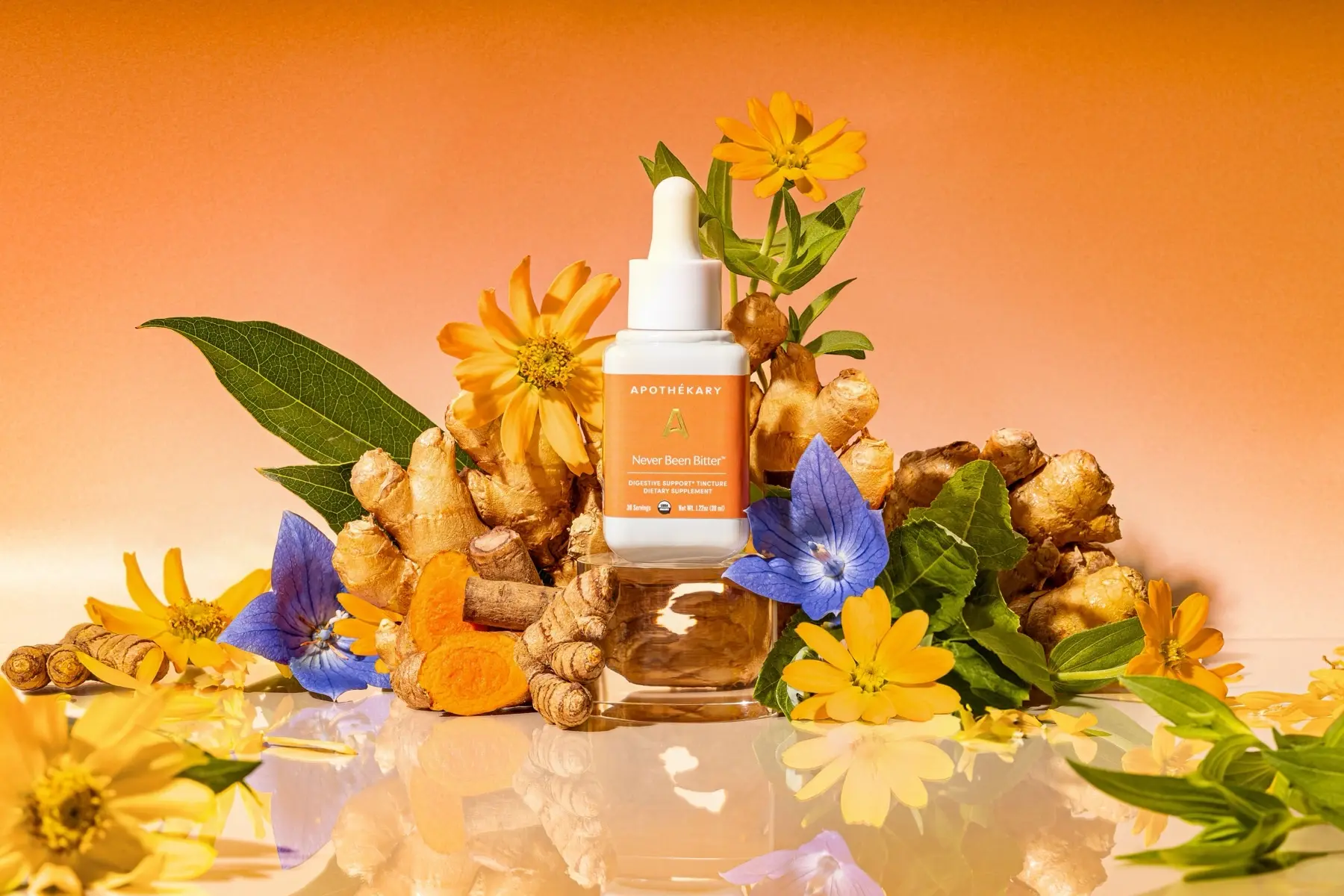Some of the earliest recorded uses of herbs were bitters with documented use dating back to ancient Egypt1. Many of the world's wild bitter plants such as–dandelion root and leaf, gentian root, and chicory root–evolved to contain bitter and sometimes poisonous constituents to protect themselves from grazing omnivores. They were, in essence, the plant's protective shield and survival mechanism. Eventually, humans and bitter plants evolved together. Humans could nibble on a small amount of a bitter plant and, in turn, improve their digestion of certain foods.
Throughout history, bitter and carminative (or aromatic) herbs have been used as digestive aids, vitality tonics, and detoxification support for the liver and other organs. But with our modern diets, bitter flavors that were once integrated into every meal, have been lost and forgotten for ultra-processed foods instead. Unsurprisingly, with the loss of our consistent bitter digestive aids and overall poorer diets—chronic digestive issues are at an all-time high. Now, with herbal medicine making a comeback in many societies, this is the perfect time to reintegrate bitter herbs back into our diets and let them work their magic on our wellbeing.
How do herbal bitters work?
Bitters herbs work by helping stimulate and improve digestion throughout the digestive tract2. Their magic begins in the mouth. A few drops of a bitters tincture directly onto the tongue can stimulate digestive secretions that jumpstart the entire digestive process even before you start eating. Once we take the first bites of a meal, the enzymes in our mouths start digesting the food by breaking down the starches in our meal. These enzymes then trigger your stomach to begin the breakdown of food, balance hydrochloric acid levels, and stimulate bile release from the gallbladder—which supports the breakdown of fats that our body needs for energy.
The best time to take bitters and reap their full benefits is 10-15 minutes before meals. But if you forget, taking afterward can still help curb digestive discomforts like gas and bloating.
The benefits of bitter herbs
Beyond improving overall digestion, bitters have an array of other health benefits including:
- Easing gas and bloating
- Increasing absorption of essential minerals and nutrients
- Curbing sugar cravings and supporting healthy glucose levels
- Supporting liver function
- Supporting the natural detoxification process
- Supporting skin health
- Regulating bowel movements
- Improving gut flora
- Easing inflammation within the digestive tract
About our bitters tincture: Never Been Bitter™
Our herbal bitters formula combines a mix of bitter and carminative herbs that have been used for centuries to stimulate digestion, support liver health, and the natural detoxification process. You will taste mild bitter notes as the herbs work to stimulate your digestion in real-time. But unlike other herbal bitters products on the market, the flavor is well-balanced with warming aromatic herbs like fresh ginger, turmeric, orange peel, and coriander seed and our tincture is naturally sweet from the use of vegetable glycerin.
The bitters herbs
Artichoke leaf (Cynara scolymus)
Most people are familiar with the vegetable artichoke and have eaten the delicious immature flower buds or “heart”. However, herbalists hold the most value in the abundant bitter leaves which stimulate digestive flow throughout the digestive tract. For centuries, artichoke leaves have been utilized around the Mediterranean as a hepatoprotective (a liver protectant), an aid for digestive complaints, and as a common ingredient in aperitif liqueurs3. Clinical medicinal research has shown the leaf’s ability to support the liver in many ways—as a choleretic (a bile-enhancer that supports digestion) and supporting toxin removal4.6 Consistent use of artichoke leaf has also shown benefits for lipid profile and even the ability to reduce discomfort with bowel movements5.7
Dandelion root (Taraxcum officinale)
Known as a common garden weed, dandelion is a powerful digestive tonic. While the entire plant has medicinal value, the roots have an affinity for the entire digestive tract including the stomach, liver, gallbladder, and gut microbiome. Dandelion roots have been utilized for centuries as a mild laxative to promote digestive flow, liver and gallbladder function, and to reduce irritation within the digestive—in addition to the skin. The roots contain inulin-–a plant prebiotic that feeds good bacteria in the gut. Dandelion root is also highly nutritious containing an array of beneficial compounds like vitamin A of which the root contains 100 grams more than an average carrot8. Recent clinical studies have shown its ability to help reduce irritation in the GI tract, support metabolism, and help improve9 motility10.11
Burdock root (Articum lappa)
Traditionally, burdock root has been used as a detoxification support, a soothing agent for various skin issues, and a digestive tonic. The nutritious roots are rich in vitamin C, iron, calcium, and magnesium. Similar to dandelion, the roots contain the prebiotic fiber inulin which promotes beneficial bacteria in the gut. Its role within the herbal formula is its mild bitter properties that stimulate the appetite while working to improve both digestive and liver function12. Burdock is also considered an alternative herb that supports the body’s natural processes of elimination via the blood and other pathways like urination, skin, and bowels13. Without proper elimination through the liver, excess hormones and toxins may recirculate back into the body leading to issues with digestion as well as more external issues with skin complexion.
Gentian root (Gentiana lutea)
In Ayurveda and traditional Chinese medicine, gentian root is still considered a tonic for the digestive system. The name is said to have come from the king, Gentius, who was said to have discovered the herb and was first “healed” by the plant14. Gentian root was widely utilized in traditional European and Eastern herbal traditions for centuries. In Iranian medicine, it was used to boost the body’s natural inflammatory response and provide support for the digestive tract, liver, wound care, and even poisonous animal bites. The bitter and aromatic roots are also used as a common ingredient in cocktail bitters and aperitifs such as Angostura and Campari. Modern studies of the herb have shown that when taken before meals, it increases digestive juices and, in turn, stimulates the digestive process while decreasing feelings of discomfort15. It also shows liver protective properties that aid in proper elimination and natural detoxification. Today, nearly 400 species of gentian root grow in hilly or mountainous regions worldwide.
Calendula flowers (Calendula officinalis)
Bright and resinous calendula flowers are most often used in herbal medicine to support skin health. The active constituents that are so beneficial for the skin can also support the health and integrity of the gut. Chronic gas and bloating are often a sign of distress in the digestive tract. Calendula flowers are an incredible way to bring us back to balance. Both traditional and modern herbal remedies use calendula to help ease irritations in the digestive tract16. It’s considered a vulnerary herb, or an herb that restores body tissues to healthy states. Lastly, calendula is considered an astringent herb17 that helps tone and strengthen our tissues. Lax tissues can lead to further digestive complications so supporting their strength is key.
The carminative herbs
Carminative herbs are rich in volatile oils to further support our digestion by helping to dispel gas and bloating from our digestive systems. These aromatic spices not only make the blend taste great, but they also promote digestive flow through their warming and dispersive properties.
Turmeric rhizome (Curcuma longa)
Colorful turmeric root gives the formula its deep orange hues that are reminiscent of traditional herbal cocktail bitters such as Angostura. For over 4,000 years, turmeric has been used across India to strengthen the body, dispel gas, and improve digestion18. Recent studies have further shown this root’s array of health benefits. The bitter and stimulating properties of turmeric root can help reduce digestion stagnation and even improve the health of our gut microbiome19. Additionally, curcumin—the main active ingredient in turmeric—has been well-researched for its ability to support the immune system and support the body’s natural inflammatory20 response21.
Coriander seeds (Coriandrum sativum)
Coriander is said to be one of the earliest aromatic spices used by humankind. All parts of the coriander plant are edible and have been traditionally used worldwide as herbal medicine22. The seeds have a special affinity for the digestive system. Their powerful carminative qualities help to rid the bodies of excess gas and, in turn, help to decrease bloating23. Coriander also supports liver function by increasing bile secretions. The benefits of these fragrant seeds extend beyond digestion—research has also shown their neuroprotective, antimicrobial, and analgesic properties24.
Ginger rhizome (Zingiber officinale)
Ginger hails from the same plant family as turmeric and carries with it many of the same benefits. It is one of the most popular digestive aids in the world and its parts are used in traditional herbal modalities and in over-the-counter conventional medicine. It has a proven ability to ease feelings of nausea, stomach cramping, and general discomfort for people suffering with digestive issues25. In addition to its digestive benefits, ginger has potent antioxidant, cardioprotective, and glucose-balancing properties26. The pungent and stimulating nature of ginger can help improve motility—in case getting backed up has got you down!
Orange (Citrus sinensis)
Citrus peels are a common ingredient in bitter tinctures but our formula includes full orange slices-–giving it more flavor and health benefits. The flesh and peels are rich in flavonoids and have an array of beneficial qualities including providing antioxidants, improving gut flora diversity, and giving the body a boost in immunity27.
Conclusion
Bitters are one of the best herbs to integrate into your daily routine. You never know when a gut disturbance can show up. When we travel, eat foods we’re not used to, or get a little nervous in our day-to-day life, having a bitters tincture around to bring ease and balance to our bellies is a good idea. Even for long-term liver health, a dropper of bitters a day can support the liver in a significant way. After all, the power of bitter herbs has been used for centuries and is proven by science to bring ease to support the digestive system, liver, and entire body. So, next time you need a bit of digestive and gut support, take Never Been Bitter™ and watch your wellbeing flourish.
https://www.sciencenews.org/article/ancient-remedy-bitter-herbs-and-sweet-wine (https://www.sciencenews.org/article/ancient-remedy-bitter-herbs-and-sweet-wine)
https://www.ncbi.nlm.nih.gov/pmc/articles/PMC4446506
https://www.herbalgram.org/resources/herbalgram/issues/130/table-of-contents/hg130-herbprofile-artichoke
https://onlinelibrary.wiley.com/doi/10.1002/ptr.6073
https://onlinelibrary.wiley.com/doi/10.1002/ptr.7247?af=R
https://pubmed.ncbi.nlm.nih.gov/26310198
https://pubmed.ncbi.nlm.nih.gov/15353023
https://www.ncbi.nlm.nih.gov/pmc/articles/PMC5553762
https://pubmed.ncbi.nlm.nih.gov/35405251
https://www.mdpi.com/2304-8158/11/18/2858/htm
https://academic.oup.com/nutritionreviews/article/70/9/534/1835513
https://www.frontiersin.org/articles/10.3389/fpls.2019.00834/full
https://www.herbalgram.org/resources/herbclip/herbclip-news/2011/burdock-the-purifying-root
https://www.ncbi.nlm.nih.gov/pmc/articles/PMC5634738
https://www.sciencedirect.com/topics/biochemistry-genetics-and-molecular-biology/gentiana-lutea
https://www.ncbi.nlm.nih.gov/pmc/articles/PMC3841996
https://www.herbalgram.org/resources/herbalgram/issues/77/table-of-contents/article3229
https://www.ncbi.nlm.nih.gov/books/NBK92752
https://www.ncbi.nlm.nih.gov/pmc/articles/PMC7551052
https://www.mdpi.com/1420-3049/23/11/2778/htm
https://pubmed.ncbi.nlm.nih.gov/26007179
https://pubmed.ncbi.nlm.nih.gov/34745916
https://www.mdpi.com/1420-3049/27/1/209
https://www.sciencedirect.com/science/article/abs/pii/S0963996917307901?via%3Dihub
https://www.ncbi.nlm.nih.gov/pmc/articles/PMC7019938
https://www.ncbi.nlm.nih.gov/books/NBK92775
https://www.ncbi.nlm.nih.gov/pmc/articles/PMC9171401


